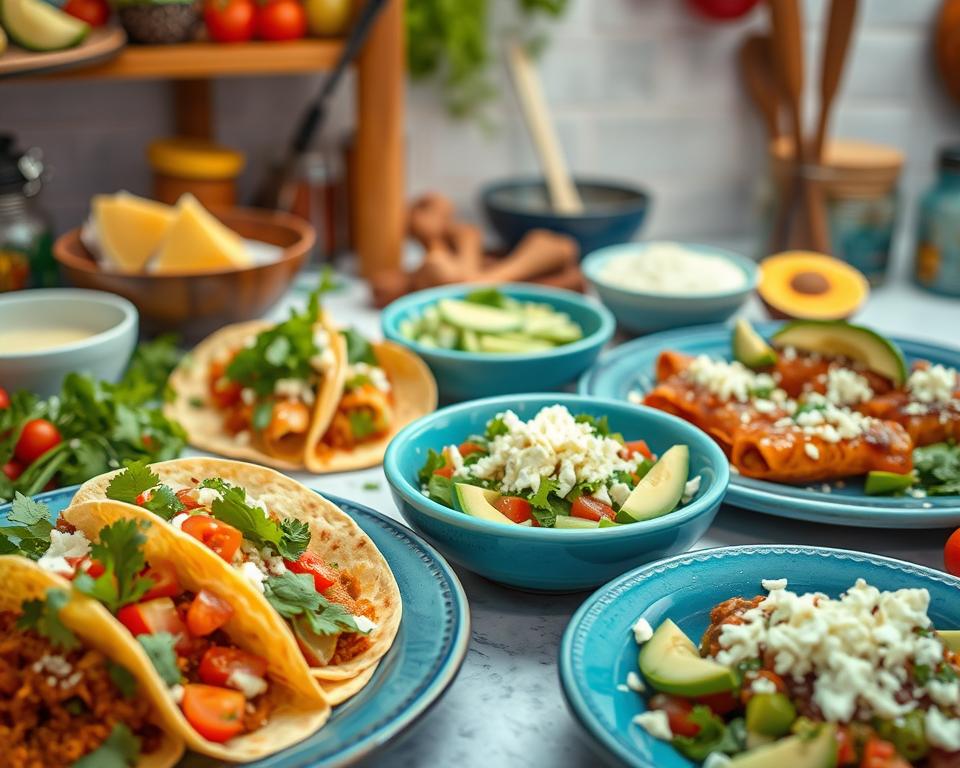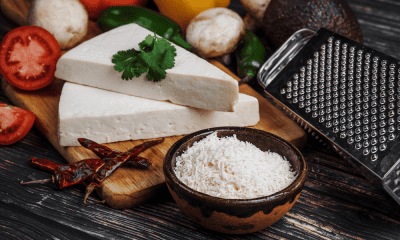Queso Fresco | Fresh Cheese: Ways to Use this Fresh Mexican Cheese
Discover the versatility of queso fresco, a tangy, milky Mexican cheese! Learn how to crumble it over salads, soups, and more in your favorite dishes.


Exploring Queso Fresco: The Authentic Mexican Cheese Delight
I still remember the first time I encountered something so fresco and flavorful, homemade queso, that it made me fall in love with Mexican cuisine on the spot. My friend’s grandmother served me a warm tortilla topped with a white cheese that had a mellow yet tangy taste, and I couldn’t stop asking for more.
Little did I know I had stumbled upon queso fresco (queso cheese), a yummy kitchen staple and a true mexican treasure. In this guide, I’ll share everything I’ve learned about this soft cheese—including a simple method if you want to learn how to make your own at home, ways to use it in dishes like enchiladas or tacos, and how it fits into many mexican culinary traditions. Once you start using queso fresco, you’ll never miss a recipe that calls for its fresh, bright flavor!
[ingredientes_receta]
Chef’s Tip: 🥛 Always use fresh, whole milk for a fuller flavor. Skim or ultra-pasteurized varieties may not curdle as reliably, affecting your final cheese’s texture.
What is Queso Fresco and How is it Made?
If you’re new to homemade queso fresco (soft cheese), you might wonder, “What is queso fresco?” In short, queso fresco cheese translates to ‘fresh cheese in Spanish. This mexican farmer’s cheese is traditionally made from cow and goat milk, though some modern versions rely solely on cow’s milk. It has a milky essence that’s both deliciously mild and tangy, yet it doesn’t melt the way other cheeses might (similar to feta). People sometimes ask, “What is queso?” or “What is queso fresco?” because the terms are often used interchangeably, especially in mexican recipes.
Understanding the Term: What is Queso Fresco?
Queso fresco and queso blanco are sometimes referred to as the same thing. In fact, these two names are often used interchangeably in various regions. You may see references to homemade queso blanco or even specialty varieties like queso oaxaca, but the core idea is a fresh cheese with a bright, milky flavor. Some folks call it literally ‘white cheese, while others describe it as a type of farmer’s cheese. Either way, it’s a beloved staple in authentic mexican cooking.
Step-by-Step: How to Make Cheese at Home
Curious about how to make queso yourself? Let me show you how to make cheese in a quick and easy way. This isn’t just any method; I consider it an easy queso recipe you can try in your kitchen. Whether you use made with raw milk or pasteurized milk, the process is simple:
- Prepare your milk in a pot.
I like to use a large saucepan, setting my milk in a pot on medium heat. Whether you use raw milk or a store-bought variety, you’ll get excellent results. - Heat the milk slowly.
Keep an eye on the temperature and heat the milk until it’s warm but not boiling (around 180°F or 82°C). Once it’s hot, turn off the stove. - Add coagulants and stir gently.
Combine either rennet (diluted in water) or lemon juice or vinegar to help form the curd. Then stir gently so the mixture starts separating into solids (curds) and liquid (whey). - Draining time is crucial.
Let the curd rest for about 15 minutes. Scoop it into a cheesecloth-lined colander and wait while the whey drains out. This draining time influences the final texture. - Season and form.
Sprinkle in salt to add a nice salty finish. Then shape your homemade queso fresco into a small wheel or simply crumble it if you want a looser consistency.
Here, you’ve seen how to make queso fresco at home in just a few steps. It’s an incredibly rewarding project, and you’ll soon have a supply of homemade queso that tastes fresh, bright, and perfect for topping your favorite mexican dishes.

Pro Advice: 🍋 Test different acid agents (vinegar, lemon juice, or lime juice) to discover subtle flavor variations. Each brings its own tangy personality to the cheese.
Ingredients Needed: Raw Milk, Rennet, and More
Below is a simple table detailing what you’ll need and why each item is important:
| Ingredient | Purpose | Notes |
|---|---|---|
| Raw or Pasteurized Milk | Base for forming the curd | Use whole cow’s milk or a mix of goat’s for more tangy flavor |
| Rennet | Helps separate the milk into curds and whey | Tablets or liquid forms also be used |
| Lemon juice or vinegar | Acidic agent to aid coagulation | Use one or the other, not both together |
| Salt | Adds a salty edge to the final cheese | Adjust to taste; a pinch usually does the trick |
Expert Trick: 🔥 Heat your milk slowly—rushing to high heat can cause scorching and uneven curds. Gentle warming ensures a consistent set and better flavor.
Ways to Use in Mexican Dishes
One of my favorite becaise versatility. Because its crumbly texture and flavor is creamy, you can enjoy it in soups, over salad, or alongside crispy tacos. Though it’s often used in mexican cuisine and is a big part of fiesta spreads, it’s also delicious on everyday meals, adding a fresh, spreadable note whenever you want a bit of creaminess without too much richness.
If you’re looking to expand your repertoire, here are some mexican recipes I absolutely love:
- Celebrate Chilaquiles with This 100% Green Easy Chilaquiles Recipe
- Easy Green Chicken Enchiladas Recipe: Delicious and Flavorful Tips
- Homemade Gorditas Recipe: Make Authentic Mexican Gorditas at Home
- Homemade Tacos Al Pastor Recipe: A Flavorful Guide to Perfection
- Esquites (Mexican Street Corn Salad)
- Authentic Carne Asada Recipe: the Best Carne Asada You’ll Ever Make!
- Chile Relleno Recipe: Authentic Mexican Chiles Rellenos
- Cotija Cheese: The Salty, Crumbly Delight and Its Best Substitutes
Classic Mexican Recipes: Tacos and Enchiladas
A fresh crumble can instantly brighten enchiladas, balancing out chile sauces’ boldness. You can also sprinkle it on tacos for a light, milky flavor that contrasts nicely with spicy fillings. Since queso fresco is a white mexican cheese that doesn’t melt, it keeps its shape in the oven, making it excellent for dishes like enchiladas suizas or baked quesadillas.

🔥 Quick Tip: 🧂 Taste and tweak the salt in the curds right after draining. Too little results in bland cheese; too much overshadows the milk’s natural sweetness.
Making Queso Rellenos with Queso Blanco
If you’re feeling adventurous, try making queso rellenos with queso blanco. A queso blanco recipe is similar to fresco, so they’re used interchangeably in many homes. Rellenos stuffed with queso blanco (or queso fresco) are creamy yet light. For extra tips, check out the link above about Chile Relleno Recipe—it offers a detailed guide on stuffing peppers with cheese and other fillings.
Adding Queso Fresco as a Topping to Your Salad
Whenever I want a refreshing crunch, I toss fresh greens, tomatoes, and a sprinkle of queso fresco as a topping. Because cheese fresco is somewhat crumbly, it pairs well with crisp veggies to give your salad extra texture. If you crave more heat, add chile flakes or a zesty dressing. You can also try stirring some into soups as a finishing flourish.
Substitutes for Queso Fresco in Recipes
Sometimes, you might need a quick substitute for queso fresco if you run out or can’t find it. The good news is some options come close to that light, tangy flavor.
Alternatives: Paneer or Cotija Cheese
I often recommend paneer if you want a mild, fresh cheese. It’s common in Indian cuisine and works well crumbled over Mexican dishes. Another alternative is cotija, which has a distinct salty bite. However, cotija cheese can be sharper than queso fresco, so use it sparingly. These cheeses are used in place of homemade queso fresco when you can’t get the real thing.
Chef’s Tip: 🧀 If you want a creamier outcome, stir in a splash of half-and-half before adding the acid. It boosts richness without complicating the process.
Using Ricotta and Feta for Different Textures
Ricotta is more spreadable and has a mellow sweetness, so it’s not identical to homemade queso fresco. Still, it can work in specific mexican cheese recipes, especially if you want to replicate that fresh, gentle taste. Meanwhile, feta is similar to feta—I know that sounds funny, but it’s known for its crumbly structure, similar to parmesan in the way you can break it up over a dish. Still, remember that feta has a more pungent tang, so it might alter the flavor profile more than queso fresco would.
Why Monterey Jack and Cheddar May Not Work
Some folks wonder if jack cheese or cheddar might do the trick. While monterey jack is excellent in melted dishes like quesadillas, it’s unlike queso fresco’s creamy but crumbly texture. Also, jack will melt into a gooey mass. That can be great for dips, yet it’s not ideal if you want that fresh sprinkling on top. Likewise, cheddar has a sharper taste and doesn’t provide the same mild background flavor or crumbly finish.
Frequently Asked Questions About Mexican Cheese
Below are some frequently asked questions (FAQs) I hear whenever I share my passion for mexican cheese at home. Read on if you’ve been curious about how best to enjoy queso fresco!
Does Queso Fresco Melt Like Other Cheeses?
No, it doesn’t. If your question is, “Will this cheese melt like queso dip?” the answer is no—queso fresco doesn’t melt like cheddar or monterey jack. Instead, it holds its shape and is best used as a topper or mixed into dishes that call for a light cheese accent.
Pro Advice: 🍃 For a fresh spin, blend in chopped herbs like cilantro, jalapeño, or chives once the curds have formed. They infuse the cheese with colorful, aromatic bursts.
Is Queso Fresco a Healthy Choice?
If you check the nutrition information, you’ll see that queso fresco can be lower in fat than aged cheeses. Because it’s a fresh cheese, it still has a pleasant milky essence without being overly rich. Everything is in moderation, but it’s typically a wholesome addition to your meals.
Can You Make Queso Fresco with Goat’s Milk?
Yes, you can. Some cooks like the extra tang that comes from goat’s milk. Since cow and goat milk can be blended or used interchangeably, you can experiment to find your preferred flavor.
The Cultural Significance of Queso Fresco
Mexico’s vast culinary heritage and queso fresco are significant in many regional foods. It’s a staple nationwide, from street snacks to celebratory feasts. When you traditionally make cheese, you continue a practice handed down for generations.
Mexico’s Culinary Heritage: A True Mexican Treasure
Because queso fresco is a mexican farmer’s cheese, it’s deeply tied to the farming communities that first produced it. Over time, it’s become a true mexican treasure, reflecting local ingredients and methods. If you travel around Mexico, you’ll discover countless variations in flavor and texture, all within the family of queso fresco.
Expert Trick: 🥄 Ensure your rennet is fully dissolved in cool water. Undissolved bits can lead to uneven coagulation, leaving you with mixed textures in the curds.
Exploring Fiesta Favorites with Queso Fresco
Anytime there’s a big fiesta at home, I keep queso fresco on the table. It’s a fantastic topper for grilled meats or spicy salsas, and it stands out in comfort foods like enchiladas or rellenos. If you want to explore more, combine it with cheeses like cotija or experiment with paneer and ricotta. Just be sure to store your queso fresco on the colder bottom shelf of the fridge and use it within a week for maximum freshness.

🔥 Quick Tip: 🥣 Don’t discard the whey—use it for soups, bread-making, or as a protein-rich liquid for smoothies. Zero-waste and full of nutrients!
Key Takeaways
- Queso fresco is often used in mexican cuisine for its crumbly, salty taste and gentle milky flavor.
- It’s sometimes referred to as queso blanco or literally ‘white cheese, and these names are often used interchangeably in mexican recipes.
- Making queso fresco at home requires milk in a pot, heating the milk, adding rennet lemon juice or vinegar, and draining the curd.
- Store your queso fresco on the colder bottom shelf and use it within a week.
Frequently Asked Questions (FAQs) – Queso Fresco
❓ What is queso fresco?
Queso fresco is a fresh, crumbly Mexican cheese made from cow’s milk. It has a mild, slightly tangy flavor and is commonly used in Mexican and Latin American dishes.
❓ Does queso fresco melt?
Unlike other cheeses, queso fresco does not melt completely. Instead, it softens when heated, making it perfect for crumbling over hot dishes without becoming gooey.
❓ What is queso fresco cheese?
Queso fresco is a traditional Mexican cheese known for its fresh, mild taste and slightly crumbly texture. It’s often used to top tacos, enchiladas, and salads.
❓ Will queso fresco melt?
No, queso fresco does not melt like cheddar or mozzarella. It retains its shape and texture when heated, making it ideal for crumbling over warm dishes.
❓ Is queso fresco the same as Cotija?
No, they are different. Queso fresco is soft and mild, while Cotija is firmer, saltier, and aged. Cotija is often compared to Parmesan due to its strong flavor.
❓ Can you freeze queso fresco?
Yes, but freezing may alter its texture, making it more crumbly. It’s best used within 3 months and works well in cooked dishes after thawing.
❓ Is queso fresco pasteurized?
It depends on the brand. In the U.S., most queso fresco is made with pasteurized milk, while in some regions, traditional versions may use raw milk.
❓ Is queso fresco similar to blue cheese?
No, queso fresco and blue cheese are very different. Blue cheese has a strong, pungent taste and a creamy texture, while queso fresco is mild and crumbly.
© 2025 Queso Fresco
Chef’s Tip: 🤏 If you prefer a crumblier texture, gently press out extra whey when shaping. For a softer, spreadable style, keep some moisture in.
Conclusion
Have you ever wondered, “What is queso fresco?” or “What is queso?” I hope this guide has shown you the many delights of this easy cheese. Whether you follow a queso blanco recipe or prefer making queso fresco from scratch, you’ll enjoy a creamy cheese that pairs wonderfully with chile sauces, tacos, enchiladas, and even quesadillas. Remember: queso fresco is best for sprinkling and crumbling, not melting—so if you’re after a gooey dip, you’ll need something else. But you can’t beat queso fresco if you want a fresh, tangy cheese that can crumble with ease.
Give it a try, and you’ll see why it’s a like queso oaxaca crowd-pleaser and a jack cheese alternative for toppings. Of course, remember that monterey jack or cheddar cheese would behave differently. But for a taste of mexico’s best, make queso fresco at home and explore how to enjoy this mexican cheese in fiesta after fiesta. It’s a staple you don’t want to miss—and now you know how to make queso fresco yourself!
This guide encourages you to try this homemade queso and helps you discover new, fun ways to enjoy it in your favorite mexican recipes. ¡Buen provecho!
Pro Advice: 🌡️ While draining, let the cheese rest at room temperature—sudden chilling can tighten the curds prematurely, affecting that tender, fresh bite.

Homemade Queso Fresco: Fresh & Tangy Mexican Cheese 🧀
Equipment
- Large stainless steel pot
- Thermometer (recommended)
- Wooden spoon or spatula
- Cheesecloth or fine mesh strainer
- Large bowl
Ingredients
- Whole milk cow’s milk: 1 gallon (3.8 L)
- Rennet: 1/2 tablet or follow package instructions for 1 gallon
- Vinegar or lemon juice: 2–3 tablespoons
- Salt: 1 teaspoon adjust to taste
Instructions
- Heat the Milk
- Warm the milk in a large pot over medium heat until it reaches about 180°F (82°C). Stir occasionally to prevent scorching.
- Add Acid & Rennet
- Turn off the heat. Dissolve the rennet in a small amount of cool water, then stir into the warm milk. Gently add vinegar (or lemon juice) and stir slowly.
- Form the Curd
- Let the mixture rest undisturbed for about 15 minutes. You’ll notice curds (solid) separating from the whey (liquid).
- Drain & Salt
- Line a strainer with cheesecloth and place it over a bowl. Carefully ladle the curds into the cheesecloth. Allow whey to drain for 15 minutes. Sprinkle salt over the curds and mix lightly.
- Shape or Crumble
- Gather the cheesecloth, gently press to remove extra whey, then shape into a disk or crumble into a container. Chill before serving.
Video
Notes
Tips & Tricks
- Temperature Control: Use a thermometer for best results.
- Extra Tang: Try substituting some cow’s milk with goat’s milk for a bolder flavor.
- Seasoning: Add herbs or chili flakes for a unique twist.
Variations
- Lime Queso: Swap vinegar for lime juice to create a bright, citrusy tang.
- Creamy Twist: Use half-and-half instead of whole milk for a richer texture.
Nutrition
Nutrition Disclaimer
The Chef Marcy is not a dietician or nutritionist, and any nutritional information shared is an estimate. If calorie count and other nutritional values are important to you, we recommend running the ingredients through whichever online nutritional calculator you prefer. Calories can vary quite a bit depending on which brands were used.








Queso fresco has always had a special place in my heart—and in my kitchen. Growing up, my abuela would crumble it over almost everything: frijoles refritos, enchiladas, nopales, even pan dulce with a little drizzle of honey (don’t knock it till you try it!). Reading this post brought back so many of those simple, beautiful food memories. I love how you explained not only how to use queso fresco, but also the respect it deserves as a staple of Mexican cooking. It’s more than just a topping—it’s comfort, family, and tradition. Thank you for honoring it with such care. 🧀❤️🇲🇽